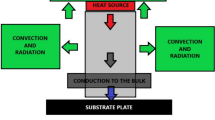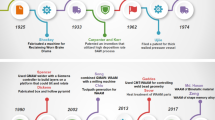Abstract
Hydrostatic stresses of copper dual-damascene interconnects are calculated by a commercial finite element software in this paper. The analytical work is performed to examine the effects of different low-k (k is permittivity) dielectrics, barrier layer and aspect ratio of via on hydrostatic stress distribution in the copper interconnects. The results of calculation indicate that the hydrostatic stresses are highly non-uniform throughout the copper interconnects and the highest tensile hydrostatic stress exists on the top interface of lower level interconnect near via. Both the high coefficient of thermal expansion and the low elastic modulus of the low-k dielectrics and barrier layer can decrease the highest hydrostatic stress on the top interface, which can improve the reliability of the copper interconnects.
Similar content being viewed by others
References
Flinn P A. Mechanical stress in VLSI interconnects: Origins, effects, measurement, and modeling [J]. Materials Research Society Bulletin, 1995, 20(11): 71–73.
Okabayashi H. Stress-induced void formation in metallization for integrated circuits [J]. Materials Science and Engineering R, 1993, 11(5): 191–241.
Ang D, Wong C C, Ramaujan R V. The effect of aspect ratio scaling on hydrostatic stress in passivated interconnects [J]. Thin Soild Films, 2007, 515(6): 3246–3252.
Jones R E, Basehore M L. Stress analysis of encapsulated fine-line aluminum interconnects [J]. Applied Physics Letters, 1987, 50(12): 725–727.
Gouldstone A, Shen Y L, Suresh S, et al. Evolution of stresses in passivated and unpassivated metal interconnects [J]. Journal of Materials Research Society, 1998, 13(7): 1956–1966.
Rhee S H, Du Y, Ho P S. Thermal stress characteristics of Cu/oxide and Cu/low-k submicron interconnect structures [J]. Journal of Applied Physics, 2003, 93(7): 3926–3933.
Paik JM, Park H, Joo Y C. Effect of low-k dielectric on stress and stress-induced damage in Cu interconnects [J]. Microelectronic Engineering, 2004, 71(3–4): 348–357.
Besser P R, Joo Y C, Winter D, et al. X-ray diffraction determination of texture and stress in damascene fabricated copper interconnects [J]. Materials Research Society Symposium Proceedings, 1999, 563: 189–199.
Shen Y L. Thermo-mechanical stresses in copper interconnects-A modeling analysis [J]. Microelectronic Engineering, 2006, 83(3): 446–459.
Tan C M, Arijit R, Vairagar A V. Current crowding effect on copper dual-damscene via bottom failure for ULSI applications [J]. IEEE Transactions Device and Materials Reliability, 2005, 5(2): 198–205.
DeOca C G M, Foley S, Mathewson A, et al. Stress modeling of multi level interconnect schemes for future deep submicron device generations [C]//Proc Simulation of Semiconductor Processes and Devices 2001. Austria: Springer-Verlag, 2001: 364–367.
Park Y B, Jeon I S. Mechanical stress evolution in metal interconnects for various line aspect ratios and passivation dielectrics [J]. Microelectronic Engineering, 2003, 69(1): 26–36.
Grilla A, Neumayer D A. Structure of low dielectric constant to extreme low dielectric constant SiCOH films: Fourier transform infrared spectroscopy characterization [J]. Journal of Applied Physics, 2003, 94(10): 1785–1790.
Nix W D, Arzt E. On void nucleation and growth in metal interconnect lines under electromigration conditions [J]. Metallurgical Transactions A, 1992, 23(7): 2007–2013.
Clement B M, Nix W D, Gleixner R J. Void nucleation on a contaminated patch [J]. Journal of Materials Research, 1997, 12(8): 2038–2042.
Shen Y L, Guo Y L, Minor C A. Voiding induced stress redistribution and its reliability implication in metal interconnects [J]. Acta Materialia, 2000, 48(8): 1667–1678.
Author information
Authors and Affiliations
Corresponding author
Additional information
Foundation item: the National Natural Science Foundation of China (No. 50871016)
Rights and permissions
About this article
Cite this article
Yuan, Gj., Chen, L. Finite element modeling of hydrostatic stress distribution in copper dual-damascene interconnects. J. Shanghai Jiaotong Univ. (Sci.) 16, 302–306 (2011). https://doi.org/10.1007/s12204-011-1148-x
Received:
Published:
Issue Date:
DOI: https://doi.org/10.1007/s12204-011-1148-x




